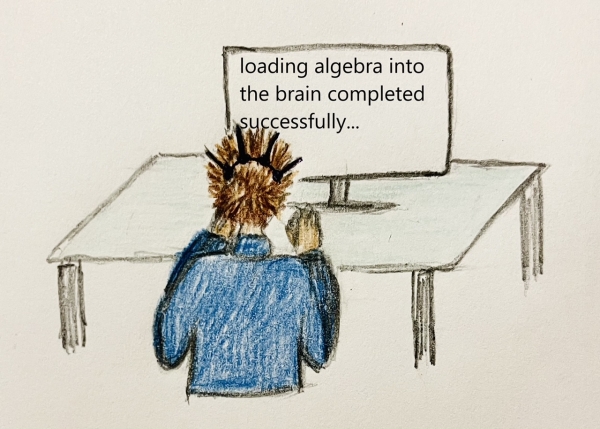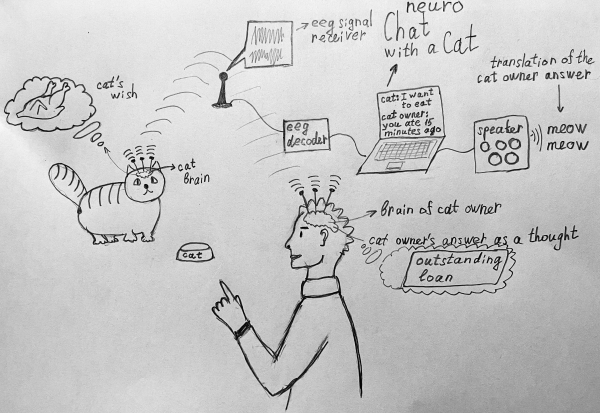Brain-Computer Interface (BCI)
Background
The desire of a person to control various things from the surrounding world with the help of the power of thought has existed since ancient times and is reflected in fairy tales and legends about wizards.

It was only in the middle of the 20th century that the first technological steps appeared to embody such a fabulous plot. The closest intermediary between the brain and any things is the computer. Therefore, the idea of reading commands from the brain, transmitting them to a computer or a microprocessor that will control a robot or some kind of technology, seems quite feasible. This is one of the main options for the brain-computer interface.
The first research on the symbiosis of man and computer began in 1960 by scientists of the DARPA agency [1] and the research of the neuro-computer interface itself began in the 1970s at the University of California at Los Angeles (UCLA) [2].
The study of the bases on which the neuro-computer interface is based is rooted in the teaching of I. P. Pavlov about conditioned reflexes and the regulatory role of the cortex. Developing these ideas, P. K. Anokhin has shown since 1935 that the feedback principle plays a decisive role in regulating both the higher adaptive reactions of a person and his internal environment. There are works by N. P. Bekhtereva from 1968 to 2008 on deciphering the brain codes of mental activity, which continue to the present time by her followers, including from the positions of neurocybernetics and ophthalmoneurocybernetics.
What is BCI?
Let's give a modern definition of BCI.
Neurocomputer Interface (NCI) (also called a direct neural interface, brain interface, brain- computer interface [3] is a system created for the exchange of information between the brain and an electronic device (for example, a computer). In unidirectional interfaces, external devices can either receive signals from the brain or send signals to it (for example, simulating the retina of the eye when restoring vision with an electronic implant). Bidirectional interfaces allow the brain and external devices to exchange information in both directions. The neurocomputer interface is often based on the biofeedback method.
The main types of brain-computer interface
There are two types of brain-computer interface:
- unidirectional: commands are read from the brain according to its activity and fed to the controlled device.
- bidirectional: a neurocomputer interface that allows the brain and external devices to exchange information with each other. This type is still under development and needs to overcome complex technical problems. In particular, solutions to the problem of how to write information to the brain.
These two types of neurointerfaces are divided into invasive, minimally invasive, and non-invasive.
Invasive methods are implemented by implanting electrodes into the brain to record its electrical activity. This option has many negative side effects — you can accidentally touch something, cause a reaction of rejection of the body, and in general, it's scary. Non-invasive ones read the electrical activity of the brain from the surface of the skull and minimally invasive are placed on the surface of the brain.
From the point of view of functions, neurointerfaces are distinguished for controlling something with the help of the brain or for restoring/supplementing its functions. The latter is relevant for brain damage in multiple sclerosis, dementia, Alzheimer's, or Parkinson's disease.

The principle of operation of BCI
The human nervous system generates, transmits, and processes electrochemical signals in different parts of the body during work. And the electrical component of these signals can be tried to "read" and interpret.
For these purposes, different methods are used, which have their advantages and disadvantages. For example, signals can be detected using magnetic resonance imaging (MRI), but the devices are too bulky.
Special substances-markers can be constantly introduced, but this can harm the body. Finally, small sensors can be superimposed or implanted in certain parts of the body. It is the use of such sensors that forms the so-called neurocomputer interfaces.
In everyday life, we can find such a device in the office of a neurologist. It is a rubber cap with a large number of wires and sensors. This is a diagnostic device, but no one prevents you from adapting it for other needs. This device can record an electroencephalogram from the surface of the head and it can be used to decode brain signals for controlling external devices or a computer.
It is necessary to distinguish between neurocomputer interfaces and "brain-computer" interfaces. The latter is only a special case of the first and deal only with the brain. Neurointerfaces interact with the whole body. In fact, we have an indirect or direct connection to the human nervous system, through which we can receive and send certain signals.
To improve the signal quality, the sensors can additionally be wetted with special liquids, perform primary signal processing "on the spot", and so on. Then the read signals are processed by specialized software and hardware and, depending on the goals, they give one or another result.

Examples of BCI
The first prototype of the neurointerface is considered to be the Stimoceiver electrode device, invented in the 1950s. It was tested on the brain of a bull, forcing the animal to change the direction of movement.
In 1972, scientists released the first neuroprosthesis for the deaf — a cochlear implant, which, according to data for 2019, is used by more than 700 thousand people in the world.
In 1998, the American neurologist Philip Kennedy for the first time implanted a neurointerface in the brain of Johnny Ray, an artist, and musician who was completely paralyzed due to a brain stem injury. He controlled the cursor on the monitor, imagining the movements of his hands.
In 2000, a group led by Brazilian scientist Miguel Nicoleles created a neurointerface that allowed a monkey to control a joystick with the help of thought. In 2021, this experience was repeated in Neuralink, but with an invasive neural interface. In 2004, an electronic neurochip from Cyberkinetics Inc. appeared, which was implanted in a paralyzed American, Matthew Bagle, so that he could control the robot arm with the help of the brain.
In recent years, major breakthroughs have been taking place in the field of neuroprosthetics. In 2015, California researchers developed a neurointerface that allows people who are paralyzed to the waist to walk. In 2016, scientists from Germany, Switzerland, and the United States were able to partially restore the damaged spinal cord of a patient using a neurointerface. In the same year, Briton Neil Harbisson, who was born color-blind, developed a special camera that converts color into sounds and sends them to the inner ear. And in 2021, a group of researchers from California created a neuroprosthesis that helps improve memory by 30%.
The main companies that produce BCI
- Neuralink USA
- Neurable USA
- Emotiv USA
- Kernel USA
- NextMind France
- MELTIN MMI Japan
- BitBrain Spain
- MindX USA
- Neurosity USA
- Nectome USA
- Paradromics USA
- Orbityl Canada
- Thync USA
- NeuroSky USA
- Neurochat Russia
- BrainCo USA
The global Brain-Computer Interface Technology market size is projected to reach USD million by 2027, from USD million in 2020, at a CAGR of % during 2021-2027.
Among the main growth factors are:
- progress in research on brain disorders and injuries, cognitive disorders
- improving the field of healthcare and prosthetics
- growing demand for biocompatible materials
- the development of related technologies — high-speed Internet, the Internet of things, artificial intelligence, neural networks, and robotics
So far, the market is dominated by non-invasive devices. Most of them are mobile EEG headsets or helmets with a different number of electrodes and a set of functions.

Acknowledgement

This web page is created by Dr. Elena Popova, Head of Astronomy Research Center, Bernardo O'Higgins University, Santiago, Chile
References
- Licklider, J. C. R., Man-Computer Symbiosis, IRE Transactions on Human Factors in Electronics, volume HFE-1, pages 4-11, March 1960
- Vidal, J.J., Toward direct brain-computer communication, Annual Review of Biophysics and Bioengineering, 1973, 2 (1): 157–80. doi:10.1146/annurev.bb.02.060173.001105. PMID 4583653.
- Krucoff, Max O.; Rahimpour, Shervin; Slutzky, Marc W.; Edgerton, V. Reggie; Turner, Dennis A. Enhancing Nervous System Recovery through Neurobiologics, Neural Interface Training, and Neurorehabilitation, Frontiers in Neuroscience., 2016), 10: 584, doi:10.3389/fnins.2016.00584. PMC 5186786. PMID 28082858.
